
Patricia Barry arrives at the St. Louis Bread Company to meet with me. I’d seen photos of her earlier so she’s easy to spot. She had also texted ahead to say: “Look for the world’s cutest baby.” Barry is a beautiful and vibrant woman. You would never know she is the mother of four small children all under the age of nine, including a set of twins and the aforementioned world’s cutest toddler. You would also never know that this 33-year-old was recently diagnosed with stage-three appendix cancer.
Barry grew up in a sweet house in North St. Louis County, Missouri, the last home on a dead-end street in a lush, green, densely-populated suburb of St. Ann, a few miles south of the Lambert-St. Louis International Airport. Behind her house was a wooded area with a meandering waterway called Coldwater Creek. It was a perfect childhood home, made for spending hot summer days exploring the outdoors. “We’d spend all our free time outside,” recalls Barry, who now lives in Chesterfield, a neighborhood about 18 miles from her former home. “My dad built us swings and we played in the wooded area and in the creek, making houses with branches and sticks and anything we could find.”
Barry always thought of the 15 years she spent in that house as good ones. Then, while in the hospital recovering from a surgery that removed her cancerous appendix and part of her colon last September, she received an odd email from a friend. It didn’t say much. Just that she should look up Coldwater Creek. A Google search revealed shocking information. It seemed there was an unusually high number of rare cancers and diseases afflicting current and former residents of several neighborhoods that Coldwater Creek ran through, including St. Ann. The most likely cause, the news reports and websites she scanned indicated, was the creek, which had been contaminated by radioactive waste from the World War II era.
It was the first time Barry learned that she’d grown up near a nuclear waste dump. The news tainted memories of her idyllic childhood forever. “I felt like everything was great when you were a child and then 20 years later you have cancer because of it,” she says, her voice choking up.
The story of how nuclear waste got into Coldwater Creek dates back nearly three-quarters of a century. In 1942, Mallinckrodt Chemical Works, a company based in downtown St. Louis, began secretly processing uranium for the Manhattan Project — the US government research project that produced the first atomic bombs. The project was codenamed “Tube Alloy Process.” Even after the war ended in 1945 following the US dropping nuclear bombs on Hiroshima and Nagasaki (which killed at least 129,000 Japanese citizens and remain the only use of nuclear weapons in history), Mallinckrodt continued to process tens of thousands of tons of uranium for the US military through the early years of the Cold War. From 1942 to 1957, the company was the only source of processed uranium in the entire country. During this time, Mallinckrodt processed about 50,000 tons of uranium at various locations in and around St. Louis. The company now manufactures pharmaceuticals, including opioids.
Processing the radioactive element, however, produced enormous amounts of nuclear waste, some of which was more radioactive than the processed uranium itself. As early on as 1946, Mallinckrodt began running out of space to store this waste on its facilities. The company began shipping the waste offsite to a 22-acre field acquired by the Manhattan Project, in a sparsely populated area north of St. Louis City, near the Lambert-St. Louis International Airport.
From 1946 to 1962, before there were any federal laws regulating disposal of hazardous waste, an estimated 133,007 tons of radioactive refuse was carelessly dumped at this site. Some of it was buried, some stored in barrels that soon rusted, and the rest simply left in piles, open to the elements. (Much of the waste was transported to the site in uncovered dump trucks, contaminating the land along the haul routes.) According to a September 1946 news report in the St. Louis Post-Dispatch, company officials assured the public that the material was harmless, claiming that it was “the type of refuse that any ordinary commercial firm of this type would store there.”
Over the years, wind erosion, stormwater runoff, groundwater discharge, and flooding carried unknown volumes of this extremely hazardous waste into Coldwater Creek, a 20-mile tributary of the Missouri River that runs past the westernmost boundary of the site and flows along several homes, parks, and schools in North St. Louis County municipalities such as Florissant, Hazelwood, Berkeley, and St. Ann. The toxins that ended up in Coldwater Creek include uranium-238 (half-life of 4.5 billion years) and thorium-232 (half-life of 14 billion years). The creek is prone to flooding, which it has done as far back as anyone can remember and still does to this day, bringing muddy sediments into backyards, basements, and playing fields.
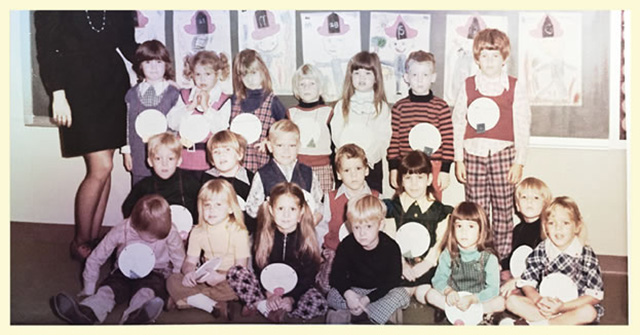 Many children who went to Wedgewood Elementary in the 1970s were diagnosed with cancer as adults. The city of Florissant’s Wedgewood subdivision has one of the highest cancer rates in North St. Louis County. (Photo: Jeff Armstead / Coldwater Creek Facts)
Many children who went to Wedgewood Elementary in the 1970s were diagnosed with cancer as adults. The city of Florissant’s Wedgewood subdivision has one of the highest cancer rates in North St. Louis County. (Photo: Jeff Armstead / Coldwater Creek Facts)
In 1966, the now-defunct Atomic Energy Commission sold the waste at the site to a private company that moved some of the material half a mile away to Latty Avenue in Hazelwood — another journey that spilled material and contaminated properties along the way. The waste dumped at Latty Avenue was bought up in 1969 by yet another company, Cotter Corporation, which began drying and shipping it to Colorado. However, the drying process left behind some 8,700 tons of radioactive barium sulfate. During July to October 1973, Cotter quietly mixed this residue with 39,000 tons of topsoil and dumped it at the West Lake Landfill in Bridgeton, a few miles away, where it’s currently posing another potentially explosive problem. (See: “Something’s Burning“)
In 1974, the US Department of Energy established the Formerly Utilized Site Remedial Action Program (FUSRAP) to clean up sites contaminated by the federal government’s activities involving radioactive materials. But the contaminated sites in St. Louis city and county weren’t included under the FUSRAP program until 1990. Funding for that work was approved only in 1997, half a century after the dumping began. Eventually, more than 100 contaminated locations would be identified throughout the St. Louis region. Of the 46 FUSRAP sites across the country, St. Louis (city and county) is the largest both in terms of acreage and the quantity of radioactive waste material.
Meanwhile, from the 1950s through the ’70s, North St. Louis County, which encompasses 18 municipalities, went through a population boom. As new subdivisions and supporting businesses began sprouting up, construction work near the dumpsite disturbed the radioactive waste and spread it farther around the county. Some of the waste that had been previously buried was exposed to air. In some instances, contaminated soil was used as fill for lawns. In the late 1990s, the Army Corps of Engineers, which is charged with the cleanup of FUSRAP sites, found radioactive waste five miles downstream from the airport storage site during a bridge renovation project. Soil samples taken by the Corps back then found that the ground was contaminated as deep as 20 feet in some places with forms of uranium, thorium, and radium.
Oddly enough, until recently, few residents of North St. Louis County knew much about their area’s nuclear past. And even many of those who did thought of it as a historical artifact that had nothing to do with their present-day lives.
Today, North St. Louis County, with a population of nearly 400,000, is one of the most diverse regions in St. Louis County. Cities here include Ferguson, which flashed into the national spotlight in 2014 after a white police officer shot and killed 18-year-old Michael Brown, sparking riots and, eventually, a national debate about race, the militarization of police, and social justice. The county’s toxic atomic legacy, however, hasn’t garnered the same kind of attention. Now a group of local residents is working to change that.
For Jenell Rodden Wright, the nightmare began about seven years ago, around the time of the 20-year reunion of Florissant’s McCluer North High School class of 1988. “That’s around the time we all started jumping on Facebook and reconnecting,” she says. In the process of catching up with childhood friends, from both her high school and grade school (which was in the neighboring Hazelwood), she discovered that many of them were suffering from cancers or other unusual diseases. Yet others had passed on.
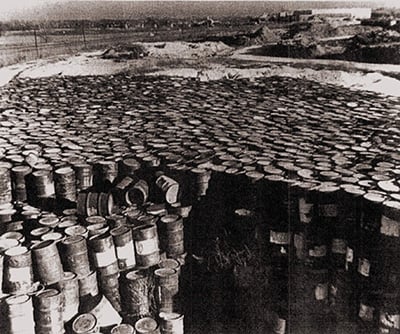 Archival image of rusting barrels of radioactive waste at the dump site near the Lambert-St. Louis International Airport. (Photo: US Department of Energy)“In a six-house radius around my home, I knew four people with brain cancer, including a child. I looked up old neighbors on Facebook and asked them if they were OK, and they were not OK. Someone had lymphoma, someone had autoimmune disease, someone had lupus, some were having babies with birth defects.”Wright, who lived in the same house in Florissant for the first 27 years of her life, says the number of her peers and some of their children who were seriously ill or had died seemed so high that she began to think it had to be more than just bad luck. “Knowing statistics, knowing the conservative lifestyle these people had, I knew something was odd,” says the Ernst & Young certified public accountant and former corporate executive.
Archival image of rusting barrels of radioactive waste at the dump site near the Lambert-St. Louis International Airport. (Photo: US Department of Energy)“In a six-house radius around my home, I knew four people with brain cancer, including a child. I looked up old neighbors on Facebook and asked them if they were OK, and they were not OK. Someone had lymphoma, someone had autoimmune disease, someone had lupus, some were having babies with birth defects.”Wright, who lived in the same house in Florissant for the first 27 years of her life, says the number of her peers and some of their children who were seriously ill or had died seemed so high that she began to think it had to be more than just bad luck. “Knowing statistics, knowing the conservative lifestyle these people had, I knew something was odd,” says the Ernst & Young certified public accountant and former corporate executive.
The numbers worried her so much that her husband encouraged her to start keeping a list of ill or deceased friends and community folks. By 2011 her list included 274 people. “We were going to funerals frequently or visiting sick friends,” she says. “It was heartbreaking.” Rumors started floating around about there being “something” in the creek that was killing people.
Around the same time, another McCluer North grad, Jeff Armstead, created a Facebook group called “Coldwater Creek — Just the Facts Please” as a place for former residents to report their illnesses. Wright jumped on board and soon became one of the group’s key members (who between them have advanced degrees in science, nursing, statistics, economics, accounting, and political science). The group began investigating the possibility of a cancer cluster in the communities surrounding North St. Louis County’s Coldwater Creek. “We knew we were sick and dying but we didn’t know why,” Wright says.
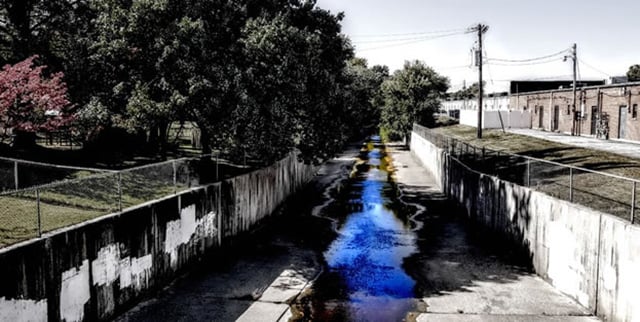 Coldwater Creek, which has been diverted many times to make way for developments. (Photo: Lori Freshwater)
Coldwater Creek, which has been diverted many times to make way for developments. (Photo: Lori Freshwater)
The response to the Facebook group was overwhelming. “At one point I had more than 500 people who emailed me privately telling me about their illnesses,” Wright says. Days later, the group learned that the creek that ran past many of their neighborhoods had been contaminated with uranium- processing waste. Digging further, they learned more about the haphazard dumping, the years of neglect, and about the health impacts of radioactive contamination.
“I think we didn’t sleep for two nights,” Wright says. “It became clear to us, from the science and medical standpoint, that what we were intuitively suspecting made sense. The puzzle fit together. We had a huge environmental issue beyond the worst imagined.”
By 2013, the number of cases being reported on the Facebook page was so overwhelming that the group created an online health survey for current and former residents of North St. Louis County, which would eventually lead to a well-organized and sustained community effort to learn the truth behind Coldwater Creek. (The Facebook group now has more than 13,000 members, many of whom report heartrending stories of pain and suffering endured either by them or their loved ones.)
“We had a lot of anecdotal evidence, but we knew there was no way we were going to get any help from anybody unless we started documenting things and getting some numbers and facts,” Wright says. A self-described “numbers person,” she was one of the key organizers of the survey along with her classmate Diane Schanzenbach, an economics and health researcher at Northwestern University.
Until recently, few residents in this suburban area knew much about its nuclear past.
The group also tried to reach out to former residents who had since moved away. Kim Visintine, a registered nurse and another core group member whose son, Zach, was diagnosed with an aggressive brain cancer at birth, explains why. “This is something we try to bring up with health researchers: Chronic exposure to low-level ionizing radiation can take decades to [manifest] in exposure victims or their children. I lived 27 years in the area and moved to a different zip code, 10 miles away, when my son was born. So he was never captured in the disease registry data [that states are required by law to keep, but only by zip code]. That is why we started the health survey, to capture where people grew up here…. This was the only way we could tie things back to the creek.” Zach died in 2006 when he was six years old. After Zach passed, Visintine, who used to be an engineer with Boeing, went back to school and trained as a registered nurse because she wanted to help others who were suffering.
As they painstakingly mapped out the cases, Wright, Schanzenbach, and other members of the group were struck by the statistical improbability of what they were seeing. They found higher than average levels of leukemia, rare brain tumors, breast, and colon cancers — all known to be associated with nuclear radiation exposure according the Centers for Disease Control and the US Environmental Protection Agency. “We realized that we were seeing the effects of long-term exposure among people who grew up in North St. Louis County from the 1960s to the 1980s when the contamination was at its worst,” says Wright.
Which meant residents who most loved being outdoors, playing by the creek or wading around in it to catch crayfish on hot Missouri days, were probably the most at risk. Not that those who stayed home were safe either, since the creek often flooded into lawns, backyards, and basements. And then there was the wind, which likely blew dust off the open piles of waste into the air that they breathed.
“The age range [of people getting sick] really stuck out to me,” says Angela Helbling, another core member of the citizen’s group, who spent her “entire childhood on the banks of Coldwater Creek.” Helbling’s mother died of brain cancer in 1996 when she was 39, her father is suffering from stage four throat cancer. Helbling, who’s in her late 30s, suffered from a rare salivary gland tumor a few years ago. “Through my own research, I discovered that my rare tumor is commonly seen in Hiroshima bomb victim survivors,” she says.
Over the past four years, more than 100 current and former North St. Louis County residents have filed lawsuits against Mallinckrodt and the other companies involved in the manufacture and disposal of the nuclear waste, alleging these businesses’ reckless and negligent actions caused their cancers and other illnesses.
According to the latest data collected by the survey, as of 2015 there were 1,993 self-reported cancer cases, of which 45, including Patricia Barry’s, were cases of appendix cancer — a disease so rare that it’s usually seen in 1 of about 500,000 people a year in the United States.
In total, there were more than 2,725 reported cases of multi-generational illnesses, including rare cancers, thyroid problems, infertility, autoimmune diseases, and genetic mutations in children.
The group had from the start been pressing state and federal health authorities to conduct their own investigations to see if there’s a link between radiation and the illnesses. However, it was only after Wright went to them with her initial anecdotal list of health victims, and spoke to a local television station about her suspicions, that the Missouri Department of Health and Senior Services responded to people’s concerns by conducting its own health study. The study’s finding, released in early 2013, concluded that increased cancer risk due to radiation exposure was “unlikely.” But once critics pointed out that the study didn’t account for people who grew up in North St. Louis County in the ’60s to ’70s but had moved away (the county’s population had seen a 75 percent turnover in the past 20 years or so) the department revised its study in September 2014 to factor that shift in. It ended up finding higher than normal rates of some cancers in the population, including leukemia, breast, and colon cancers — just as the citizen’s survey had. The new study also revealed higher rates of childhood brain cancer in some areas around Coldwater Creek.
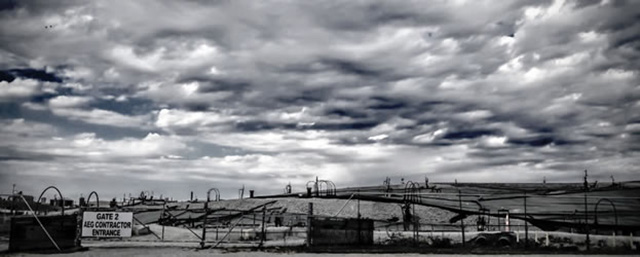 About 87,000 tons of atomic waste lie buried in West Lake Landfill in the City of Bridgeton. An underground fire in a neighboring landfill is headed towards the radioactive material. (Photo: Lori Freshwater)
About 87,000 tons of atomic waste lie buried in West Lake Landfill in the City of Bridgeton. An underground fire in a neighboring landfill is headed towards the radioactive material. (Photo: Lori Freshwater)
But without a more comprehensive study, there is no way to link these diseases directly to exposure to radioactive contamination. So the health department requested the Centers for Disease Control (CDC) conduct further studies in the area. It also sent a joint letter, along with the Missouri Department of Natural Resources, to the Pentagon, asking the Army for “top priority funding” in order to speed up the cleanup of FUSRAP sites since “the potential exposure and movement of contaminated materials” was of “grave concern.”
The Army took seven months to respond. The April 2015 reply, by Assistant Secretary of the Army Jo-Ellen Darcy, did not commit to any additional funding. Instead it urged district officials to share their concerns with the Army Corps’ St. Louis District team and assured them in a letter that “St. Louis sites were given every consideration in the formulation of the Fiscal Year 2016 Budget, along with many other worthwhile programs, projects and activities across the Nation in competition for limited Federal resources.”
Rene Poche, chief of public affairs for the Corps’ St. Louis District, told the Journal that the district had been allocated about $34 million for 2016 — almost a third of the $104 million allocated to the Army Corps for its entire FUSRAP program this fiscal year. “It should be more than enough to do what we need to do this year,” he said.
Until last year, the Army Corps had been testing and cleaning up areas around the two “source” sites in North St. Louis County where the radioactive waste had been originally dumped — by the airport and Latty Avenue. (It says these sites have been “fully remediated” now.) Both these sites are located in sparsely populated industrial areas, separated from the densely populated residential part of North St. Louis County by National Highway 270. There was no evidence that residential neighborhoods along Coldwater Creek may also have been contaminated when the creek flooded in the past, simply because these areas had never been tested.
When Wright found out about this in 2013, she turned up at the Corps’ trailer at one of the cleanup work sites with a poster of a map of the homes of 750 people who had died or were sick in Coldwater Creek-adjacent neighborhoods, victims whose information she had personally compiled. “I told them, ‘Show me there are no radionuclides in the area and I’ll shut up.'”
Local residents kept the pressure on until, in late 2014, the Corps agreed to start testing areas north of Highway 270. And sure enough, when they started sampling the soil in the area, they found contaminated sites.
As of December 2015, the Corps had discovered low-level radioactive contamination in a total of 12 sites in residential areas along Coldwater Creek including several residential yards, neighborhood parks, and commercial properties. This was the first time in more than 15 years of the Corps’ FUSRAP work in the region that radioactive contamination was confirmed in residential properties.
“This was huge. It proved what we were saying all along. But they wouldn’t have found it if we hadn’t managed to convince them to test this area,” says Wright, who also sits on a panel overseeing the cleanup.
The Corps has, so far, tested more than 10,000 samples north of the highway along Coldwater Creek and its 10-year-floodplain area. It is working its way downstream to locate and remove contamination spread over the years by flooding. Its search, however, is restricted by law to within the creek’s 10-year floodplain. Residents say this is inadequate given how often and how far the creek tends to flood and given that the creek has been diverted in some places in the past 70 years, leaving behind “broken trails.” They want the search to be extended over the creek’s 50-year floodplain. “The dirt has been moved around [by the creek] so much that radionuclides are sure to have migrated much further,” Wright says. “We are fearful that there are many areas that are constantly being used by people that are going to go undetected. We believe [the contamination is] now hidden several inches below the surface. So if you are going to dig a garden or are working in your backyard it’s all going to come up.”
Poche says the Corps is using a “follow the radiation method” to figure out what areas to test next. That is, if a sample taken from a certain area comes back positive for radiation, they test additional samples around the area. “We are going to go wherever the sampling leads us to,” he says. Poche says sampling would extend beyond the 10-year floodplain only if evidence of further contamination is found.
It could take researchers several years to figure out whether a cancer cluster exists in the neighborhoods around Coldwater Creek.
It’s hard to estimate how long it will take for the entire length of the creek to be tested and cleaned up. “I think it depends on how much we keep finding,” Poche says. “I think this program could easily go on for another 5 to 10 years. We are making progress, but I know it will never be fast enough for everyone.”
On the health front, response from the Centers for Disease Control, too, took a while. Last November, more than a year after the county health department approached the center for help, it was announced that scientists from the CDC’s Agency for Toxic Substances and Disease Registry would be teaming up with county health officials to assess health risks from radioactive contamination in and around Coldwater Creek.
This was one of the things the Coldwater Creek Facts group had been pushing for. They hope the formal CDC health assessment will lead to further studies that will confirm that the cancers and other illnesses afflicting people in the area are linked to the spread of radioactive waste in the Coldwater Creek floodplain. And they hope that such a finding will lead to funding to speed up the Army Corps cleanup of the creek and the surrounding area, and also address the community’s health concerns.
The group wants North St. Louis County to be included in the Department of Justice’s Radiation Exposure Compensation Act Program as a “downwinder” community, which would make them eligible for regular health screenings for radiation exposure as well as provide grants to local public health departments for education on, and early detection of, radiogenic cancers and diseases. They also want it to be recognized that anyone who has previously lived in the area for an extended period of time is at risk.
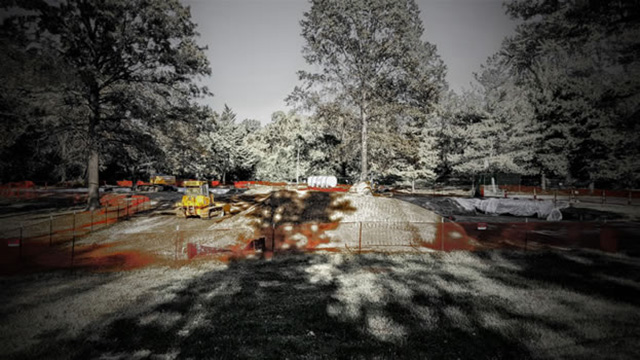 In 2015, the Army Corps found low-level radioactive contamination in 12 sites in residential areas along Coldwater Creek, including St. Cin Park in Hazelwood. (Photo: Lori Freshwater)
In 2015, the Army Corps found low-level radioactive contamination in 12 sites in residential areas along Coldwater Creek, including St. Cin Park in Hazelwood. (Photo: Lori Freshwater)
“The best way to deal with this is by educating current and former residents and medical professionals that we are an ‘at risk’ population so that they know what to look for and can plan patients’ treatment options based on that information,” says Visintine. “We cannot change our exposure…. We can only look forward and figure out a way to make it better, and to stop the illnesses from occurring in generation after generation.”
But proving that the North St. Louis County community’s diseases were caused by exposure to radiation is going to be a tough task, even for the CDC.
While the World Health Organization and EPA accept that long-term exposure to low-level nuclear radiation is linked to an increased risk of cancer, several epidemiologists interviewed for this story concurred that establishing a cancer cluster — and its cause — is a complicated affair.
For starters, as per the American Cancer Society, one in three people is expected to develop cancer at some point in their life. Health departments across the country receive an average of 1,000 reports of possible cancer clusters every year. Most are not investigated because they don’t fall within the very specific definition of a cancer cluster, which the CDC and National Cancer Institute define as “a greater-than-expected number of cancer cases that occurs within a group of people in a defined geographic area over a period of time.” Among the ones that are investigated, only 10 percent show up as having higher-than-expected cases, and even in those instances, detailed investigations often fail to identify specific causes for the illness.
“What we can say is that there is a concern but there is no evidence of a cancer cluster yet,” Dr. Adetunji Toriola, an epidemiologist at Washington University’s Institute for Public Health, told the Journal regarding the Coldwater Creek cases.
The one thing all the medical experts concurred on, however, was that the number of reported appendix cancer cases — 45 in a population of about 300,000 — seems abnormally high. “But there’s so much to piece out that it’s difficult to say what’s going on there at the moment,” says Toriola, who specializes in predicting cancer risk at the population level. “It’s going to take a large and concerted effort to figure that out.”
The CDC health assessment, which kicked off in January, is expected to take 18 to 24 months to complete. In case the scientists confirm that the illnesses are linked to radiation exposure, they would have to do further studies to establish a cancer and disease cluster exists in the area. Implementation of any recommendations they make following that will likely take even longer.
Mary Oscko is a determined woman, and she is determined that we hear her story. She wants us to know about how she walked 24 laps each day in Hazelwood’s St. Cin Park, which is pretty much her backyard, thinking it would keep her healthy and help her live to see her grandchildren grow up. She wants us to know that she has never smoked a cigarette in her life. “I was one of those annoying people, telling people not to smoke.” And she wants us to know that there is “a big problem” in North St. Louis County and, “It’s in the soil.”
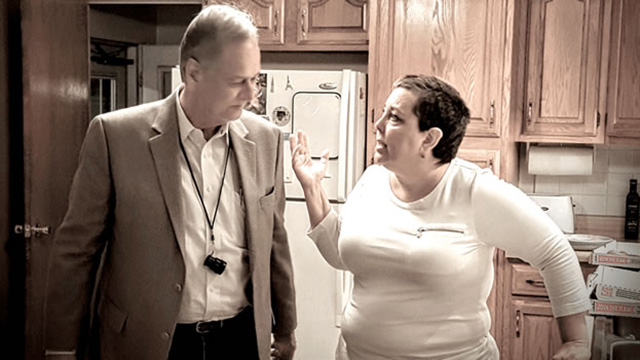 Mary Oscko, who has lived in the same house by St. Cin Park for 29 years, was diagnosed with stage-four lung cancer in 2013. (Photo: Lori Freshwater)
Mary Oscko, who has lived in the same house by St. Cin Park for 29 years, was diagnosed with stage-four lung cancer in 2013. (Photo: Lori Freshwater)
Oscko has lived in the same house by St. Cin Park for 29 years. Coldwater Creek runs past her home, which sits just high enough to avoid being inundated when the creek floods. “I’ve seen the waters come up real fast. We would watch as neighbors kayaked past our house,” she says. St. Cin Park is one of the places where the Army Corps found radiation contamination last year. It’s since been closed down for the cleanup, which is expected to be completed any day now. The backyards of three nearby homes, too, tested positive for contamination last year.
Oscko was two days from taking the final test to become a registered nurse in December 2013 when she was diagnosed with stage-four lung cancer. She had always wanted to be a healer and had gone back to school after her son, the younger of her two kids, left for college. Oscko “rocked that test” despite the shocking news. She is a registered nurse now. But the healing she must master now is her own. When she goes to the hospital, it is not to add hours to a workweek; it is to try and add days to her life.
“I’m terminal,” she says. “I know that.”
These days, home no longer feels like, well, home for Oscko. “I don’t feel like I can shut the door and feel safe any more. And I’m afraid to go outside because they are moving the dirt around in the park. I don’t think they can ever assure us that they can make this place safe to live. I want to get out of here, spend my remaining years somewhere else. But we have no equity. No one is going to buy this house.”
What worries her even more is that her children might be affected too. “My daughter was two when we moved here and my son was born here, and I do have mutated genes.” Both her children have respiratory issues. Her daughter, who’s 31, has had difficulty conceiving and has suffered miscarriages, though she does have one little boy. Oscko’s son, who’s 22, suffers from a “cycling vomiting syndrome,” triggered by migraines, that leaves him so dehydrated that he has to be taken to the ER and given saline intravenously.
Oscko had never heard of the Manhattan Project until three years ago. “I never even knew we manufactured anything to do with it here,” she says. She believes that, had people in North St. Louis County, especially doctors and healthcare professionals, known about the contamination, her cancer would have been detected earlier. “Now we are finding out that our children and grandchildren are getting sick. They knew what they were exposing us to but they covered it up. And that makes me angry.”
Oscko knows, however, that her story, and the story of what’s going on in North St. Louis County, is not unique. “There are Superfund sites all over the place. People all over the country are exposed to contamination. We have to stop this.”
She is right. Seventy years of nuclear weapons research and production, and the related disposal of millions of gallons of highly radioactive waste, have left a legacy of contamination across the United States threatening both human health and the environment. As the US Government Accountability Office has reported, cleanup of this contamination, which has migrated from haphazard disposal sites into soil and groundwater, constitutes one of the world’s largest environmental cleanup programs. The Department of Energy has estimated that it may take nearly $300 billion and several decades to remediate these sites. For Oscko and Barry and thousands of those who are sick and dying because of the toxic legacy of our nation’s war effort, that is too long a wait.
“We all feel like we are living in a movie,” Oscko says. “That we are going to wake up at some point and it will all go away like a bad dream. But it’s all real. We are the casualties of the Second World War. This mess is because they wanted to win and went and built that bomb.”
Maureen Nandini Mitra provided additional reporting for this story.
Press freedom is under attack
As Trump cracks down on political speech, independent media is increasingly necessary.
Truthout produces reporting you won’t see in the mainstream: journalism from the frontlines of global conflict, interviews with grassroots movement leaders, high-quality legal analysis and more.
Our work is possible thanks to reader support. Help Truthout catalyze change and social justice — make a tax-deductible monthly or one-time donation today.